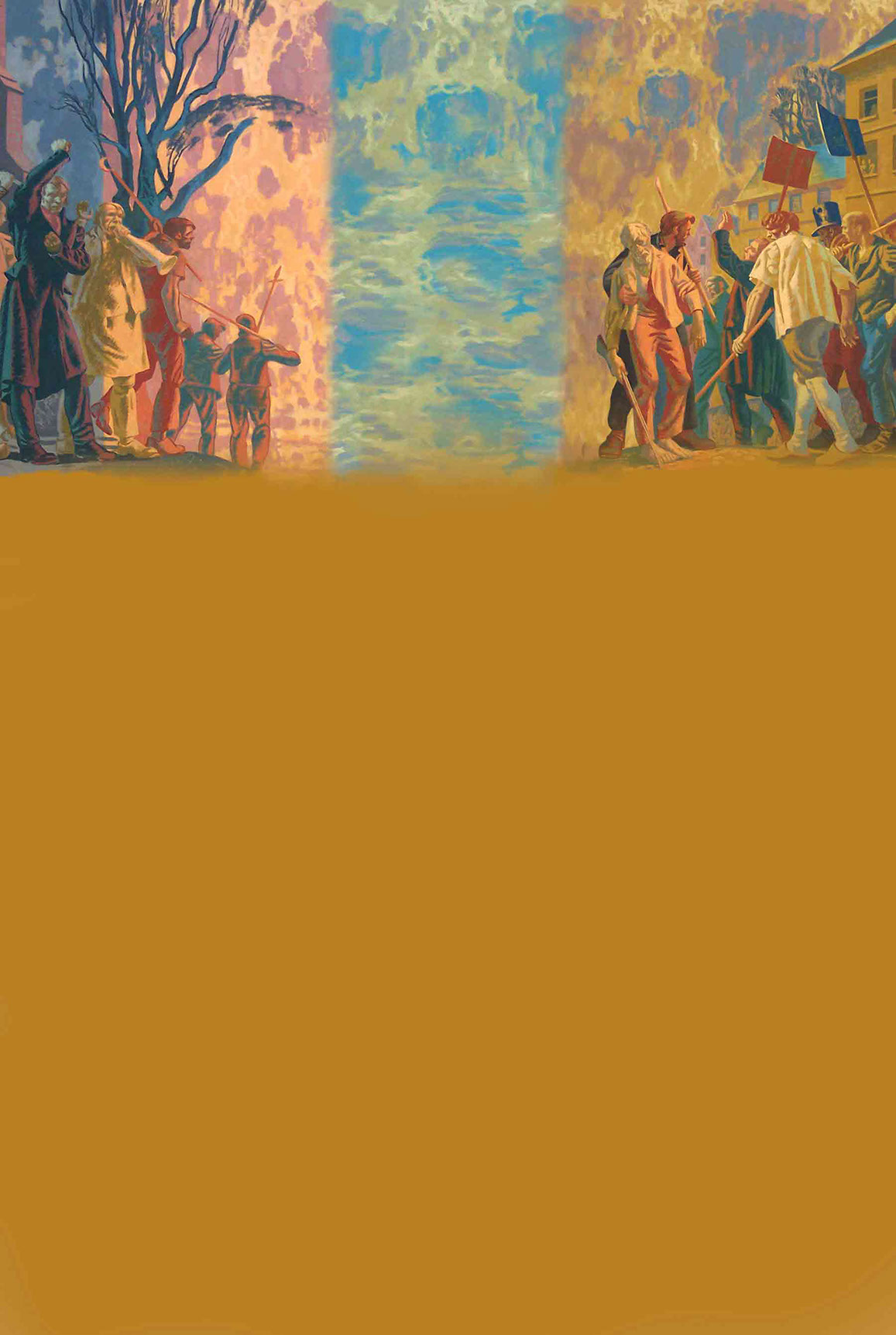


Chartist Magazine No 9 Spring 2016
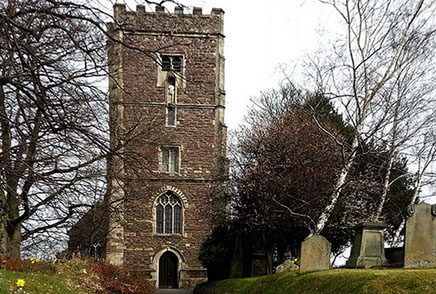 FULL REPORT: Newport Chartist Convention
FULL REPORT: Newport Chartist Convention
Newport Cathedral, Saturday 7th November 2015
“Holding the Convention for the first time at the Newport Cathedral was truly inspirational”, declared Pat Drewett, one of the three members of the Newport Chartist Commission appointed by Newport City Council.  The venue was chosen by Richard Frame of THREE IMPOSTORS publishers. This is the first time that the Cathedral has staged a conference organised by an external organisation. Pat added that although the Convention is being held at another new venue next year, “We’ll be back at the Cathedral, hopefully the year after. Richard and the organising committee are to be congratulated. They brought together a great team of Chartist experts and gave us a programme of broad appeal and interest.”
The venue was chosen by Richard Frame of THREE IMPOSTORS publishers. This is the first time that the Cathedral has staged a conference organised by an external organisation. Pat added that although the Convention is being held at another new venue next year, “We’ll be back at the Cathedral, hopefully the year after. Richard and the organising committee are to be congratulated. They brought together a great team of Chartist experts and gave us a programme of broad appeal and interest.”
He expressed his pleasure as to how Chartist Week had gone. “Yet again” he said “the Newport Museum and Art Gallery has played a vital role.” David Osmond on behalf of the Friends conducted a tour of the Chartist collection, a reminder than Newport has a ‘second to none’ permanent Chartist exhibition, opened in 2010 by actor, Michael Sheen. Steff Ellis ran a well attended ‘Down your local’ Museum session on John Frost at the Murenger and John Briggs’ photo exhibition ‘The Chartists are Coming!’ ran for a week at the Cwtsh Arts Centre, Handpost.
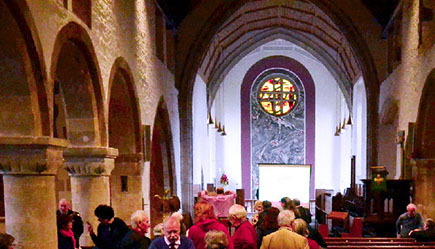
On the 4th November, both the day time Children’s March (350 pupils!) and the evening assembly at the memorial stone for the Chartist ‘martyrs’ amazingly, unlike the Chartists in 1839, escaped rain and tempest.
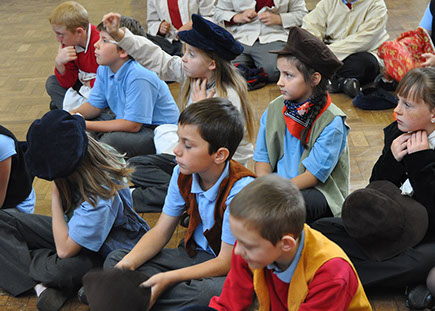
The Convention was chaired by Dr. Elin Jones, a leading history educationalist in Wales and a member of the Gorsedd.
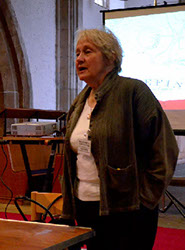 She said she was impressed by the amount of Chartism research that is obviously taking place in south Wales and “the Convention was fast becoming a show case for ‘ground breaking’ Chartist studies”.
She said she was impressed by the amount of Chartism research that is obviously taking place in south Wales and “the Convention was fast becoming a show case for ‘ground breaking’ Chartist studies”.
Opening the day’s proceedings, Lister Tonge, Dean of the Cathedral, provided a very warm welcome to an audience of more than 80 people. Wishing the Convention well, he commented that the Church had not been so accommodating to the Chartists in 1839, a time when ministers used the pulpits to preach against social and political reform. Writing in the St. Woolos Quarterly, Dean Tonge states that today’s priority for the Church “is being open and available to all... encouraging people to visit and experience this wonderful space which so often feels like Newport’s best-kept secret. Fundamental to this will be the replacement of the 20th century pews by 21st century chairs, thus making the place both flexible and comfortable.”
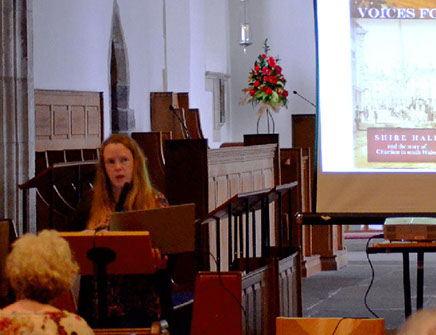
 Sarah Daley (right )and Eionion Gruffydd (from the Cynefin Project) outlined the transcription of the Chartist Trials documents and their geo-tagging on to contemporary Tithe Maps. As well as rethinking the Chartist Trials and ‘The Rising’, the Convention explored the ‘aftermath’ of Chartism post 1839 and the journeys undertaken across the world by the Gwent Chartists and their families.
Sarah Daley (right )and Eionion Gruffydd (from the Cynefin Project) outlined the transcription of the Chartist Trials documents and their geo-tagging on to contemporary Tithe Maps. As well as rethinking the Chartist Trials and ‘The Rising’, the Convention explored the ‘aftermath’ of Chartism post 1839 and the journeys undertaken across the world by the Gwent Chartists and their families.
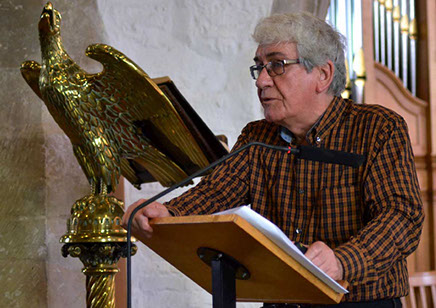
Les James (above) talked about the transportation of Frost to Tasmania and launched his new book ‘Render the Chartists Defenceless’.
Analysing the pivotal year 1839-40, Prof Chris Williams debated how and whether Chartism changed the course of events. Go to full report.
Other Lectures
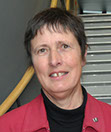 Sarah Richards (left) “Women of the Frost Family”:
Sarah Richards (left) “Women of the Frost Family”:
Her present work stems from previous work concerning a member of her own family, who married Ellen, daughter of John Frost. This work was reported at Conventions 2013 and 2014 and can be found as ‘Finding a Chartist in the Family: William Davies of Blackwood’ in the 175th Anniversary special edition of the Gwent Local History Journal no. 116 (2014).
Sarah’s research draws upon digitised newspapers as well as relevant entries, she has found in diaries belonging to her own family. These sources have enabled her to add extensively to what is known about the family which Frost left behind when he was transported to Van Diemen’s Land. Her work brings to the fore, the role of Mary, Frost’s wife and their daughters in sustaining the family during Frost’s long exile and conducting the reoccurring campaign for his pardon. Catharine Frost journeyed to Australia and supported her father during his return to the UK. Some of what Sarah has discovered of Catharine appears in "Render the Chartists Defenceless" (Les James 2015).
Many questions remain about these interesting women and Sarah continues her search. She is keen to contact anyone, whose families might have information about the Frosts.
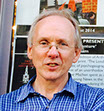 David Osmond (left) “Newport Chartism after the Rising”
David Osmond (left) “Newport Chartism after the Rising”
Despite the calamitous defeat of the insurgents at the Westgate inn, Chartism remained a popular movement in Newport after 1840.
1. Evidence from all sources suggests that Newport was the second most important centre of Chartist activity in Wales in the 1840s after Merthyr.
2. There was as much National Chartist Association (NCA) and Land Company activity in Newport as in many towns of a similar size in England, and more than in a number of bigger English places.
3. All this in the face of the peculiar local disadvantages experienced by Newport after the Rising, such as loss of imprisoned local leaders, the possible alienation of Newport Chartists opposed to violence by the Rising, and oppressive measures by the local establishment.
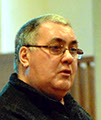 Peter Strong (left) “JGH OWEN – The Man who saved the Chartists?”
Peter Strong (left) “JGH OWEN – The Man who saved the Chartists?”
On 8th January 1840, John Frost, Zephaniah Williams and William Jones were sentenced to death for their part in the Newport rising of November 1839. The sentences could not, however, be carried out until judges at the Old Bailey had considered an objection raised at the trial, relating to the failure to issue the witness list simultaneously with the indictment. Although the sentences were upheld, most historians agree that the delay was crucial, allowing a campaign for clemency to convince the Cabinet to commute the sentences to transportation for life.
David Williams, in his 1939 biography of John Frost, argues that the error was “discovered by Geach”, Frost’s solicitor and step son. His evidence for this is an article from the Cornwall Chronicle (Tasmania) in 1846 which quoted the Newport Herald and Newport Gazette. This is curious. Why did David Williams use second hand quotes from the Cornwall Chronicle rather than going back to the information directly from the two Newport newspapers? It turns out that these two newspapers are not quite what they might seem. David Williams does not explain, and (not having the advantage of Google) may not have been aware, that these two newspapers were not published in Newport, south Wales, but in Newport, Rhode Island!
By contrast there is local evidence to suggest that the crucial role was played by Monmouth solicitor, John Gwynne Herbert Owen. A Letter to Pontypool Free Press 6th May 1863, shortly after Owen’s death stated:
“In 1840 … he defended the Chartist leaders … and detected a flaw in the Indictment that had escaped the notice of Her Majesty’s Solicitor.”
It is impossible to prove whether it was Owen or Geach who spotted the legal error and passed it on to Frost’s barrister Sir Frederick Pollock. It was Owen, however, who pushed for the early delivery of the indictment, which in turn led to the objection and delay. It is possible that he himself realised that this was an error and raised it, if not directly with Pollock, at least with Geach, who in turn passed in on to Pollock.
Perhaps David Williams does not consider this possibility because he has written Owen out of the story altogether. He goes into some detail on the important contribution of Geach in various aspects of the trial but makes no reference to Owen at all. Geach was of course an altogether more colourful character. He was the stepson of John Frost and was involved in various legal scrapes which, later in 1840, led him also to be transported.
It is clear that Owen played a more important role in the Chartist trial than is generally recognised. He represented Chartist prisoners in appearances before the local magistrates from mid-November 1839, stood in for Geach at the opening sessions of Special Commission in Monmouth while Geach was away, was allowed to stand with the prisoners in the dock as the indictment was read out in order to explain it to them, and was the only member of the legal team present when Frost, Williams and Jones were taken from gaol en route for Tasmania.
Owen can also be seen as part of one of the legacies of the Chartist Rising, that is the turn away from mass violence and open confrontation with the forces of the state towards an attempt to use the law and moral force in support or defence of workers’ rights. He spent much of the next two decades dealing with cases of workers, particularly colliers and ironworkers, who had been imprisoned for going on strike, with truck cases and representing families of men killed in pit accidents, earning himself the title ‘Poor Man’s Attorney’.
Whether or not it was Owen who saved the Chartist leaders from the noose, his work before, during and after the trial to gain justice for the Chartist prisoners plus his efforts to help workers over subsequent years mean that the ‘Poor Man’s Attorney’ deserves to be given a far more prominent place in the Chartist story than has hitherto been the case.
Back to Index for Issue 9 of the Magazine




David Osmond
Dr. Elen Jones
Sarah Daley
Sarah Richards
Richard Frame




